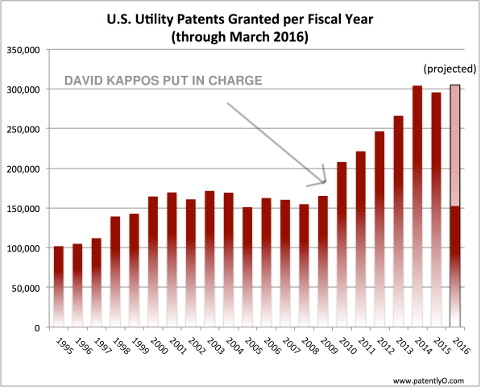

Credit: Patently-O (but annotated)
A patents exploitation firm, Mintz Levin Cohn Ferris Glovsky and Popeo PC, has just written about "Utility Patent Applications" -- a subject we touched here some days ago because of figures released by Patently-O.
"There is not much more innovation in this domain, but a lot more patents each year (see the chart above), so one might rightly suspect there's a bubble in the making.""In almost every U.S. patent suit," said the law firm, "the patentee’s counsel considers how the case could have been facilitated had the patent at issue been drafted and prosecuted differently. These considerations demonstrate that patents should be drafted and prosecuted with an eye toward the possibility of litigation. There have been several landmark decisions in patent cases that directly impact patent prosecution. This article analyzes some of those decisions in chronological order to provide suggestions for a patent prosecutor in drafting or prosecuting a patent application."
Patently-O, in the mean time, continues to write about such patents and says: "The below graph shows the number of UPR patent applications filed over the past several fiscal years (which run from October 1 to September 30), along with a simple projection of the applications for FY 2016. The vast majority of these are utility patent applications."
There is not much more innovation in this domain, but a lot more patents each year (see the chart above), so one might rightly suspect there's a bubble in the making. What good is a patent system like the USPTO if there's little or virtually no quality control? This lack of quality is why many firms ended up seeing their software patents devalued after the decision on Alice, which correctly asserted that many software patents are abstract and should thus be deemed invalid. The same could be said about the financial crisis caused by lack of quality control or slack/lenient criteria (no rigidness) when it comes to mortgages.
"Remember that the original purpose of the patent system was to provide an incentive for publication in exchange for a temporary monopoly."Consider this new comment from Nicola Searle who said “my brain started screaming when I saw “patents as a proxy for innovation.””
It sure angered the crowd of patent lawyers, who wish to believe that the more patents get filed (or more lawsuits), the better off and more innovative society will become.
Remember that the original purpose of the patent system was to provide an incentive for publication in exchange for a temporary monopoly. In light of that long-forgotten premise consider this new post from Patently-O that says: "So far in 2016, the USPTO has issued three patents that claim priority pre-GATT. These three are grandfathered in under the old 17-year-from-issuance patent term because they were filed before June 8, 1995."
"It sure angered the crowd of patent lawyers, who wish to believe that the more patents get filed (or more lawsuits), the better off and more innovative society will become."To give one example, see one patent which was "filed in 1973 but was held under a secrecy order until 2010."
Well, patents were about PUBLICATION originally. If they're not even being published for so many years, how is one supposed to think of the USPTO as seeking to maximise innovation (as opposed to maximising the number of granted patents)?
China, like the US (SIPO like USPTO), has lowered patent quality and now it’s another Texas with a litigation mess, based on those who love patent lawsuits (IAM 'magazine'). One can only hope that Battistelli won't get his way at the EPO and cause similar damage inside Europe, e.g. with the UPC. More on that in our next post... ⬆